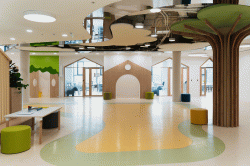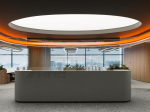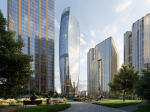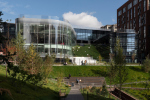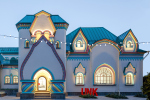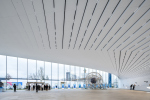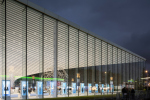24.10.2025
UNK:
Back to Firm’s Profile
04.09.2025
Elena Petukhova. Perpetuum Mobile
The interior of the headquarters of Natsproektstroy, created by the IND studio team, vividly and effectively reflects the client’s field of activity – it is one of Russia’s largest infrastructure companies, responsible for logistics and transport communications of every kind you can possibly think of.01.09.2025
. Champions’ Cup
At first glance, the Bell skyscraper on 1st Yamskogo Polya Street, 12, appears strict and laconic – though by no means modest. Its economical stereometry is built on a form close to an oval, one of UNK architects’ favorite themes. The streamlined surface of the main volume, clad in metal louvers, is sliced twice with glass incisions that graphically reveal the essence of the original shape: both its simplicity and its complexity. At the same time, dozens of highly complex engineering puzzles have been solved here.05.05.2025
Julia Tarabarina. In Orbit of Moscow City
The Orbital business center is both simple and complex. Simple in its minimalist form and optimal office layout solution: a central core, a light-filled façade, plenty of glass; and from the unusual side – a technical floor cleverly placed at the building’s side ends. Complex – well, if only because it resembles a celestial body hovering on metallic legs near Magistralnaya Street. Why this specific shape, what it consists of, and what makes this “boutique” office building (purchased immediately after its completion) so unique – all of this and more is covered in our story.21.03.2025
Julia Tarabarina. Daring Brilliance
In this article, we are exploring “New Vision”, the first school built in the past 25 years in Moscow’s Khamovniki. The building has three main features: it is designed in accordance with the universal principles of modern education, fostering learning through interaction and more; second, the façades combine structural molded glass and metallic glazed ceramics – expensive and technologically advanced materials. Third, this is the school of Garden Quarters, the latest addition to Moscow’s iconic Khamovniki district. Both a costly and, in its way, audacious acquisition, it carries a youthful boldness in its statement. Let’s explore how the school is designed and where the contrasts lie.05.09.2024
Julia Tarabarina. Flexibility and Acuteness of Modernity
Luxurious, fluid, large “kokoshniks” and spiral barrel columns, as if made from colorful chewing gum: there seem to be no other mansion like this in Moscow, designed in the “Neo-Russian-Modern” style. And the “Teremok” on Malaya Kaluzhskaya, previously somewhat obscure, has “come alive with new colors” and gained visibility after its restoration for the office of the “architectural ecosystem” as the architects love to call themselves. It’s evident that Julius Borisov and the architects at UNK put their hearts into finding this new office and bringing it up to date. Let’s delve into the paradoxes of this mansion’s history and its plasticity. Spoiler: two versions of modernity meet here, both balancing on the razor’s edge of “what’s current”.14.03.2024
Alyona Kuznetsova, Julia Tarabarina. Arch, Pearl, Wing, Wind
In the social media of the governor of the Omsk region, voting was conducted for the best project for the city’s new airport. We asked the finalists to send over their projects and are now showcasing them. The projects are quite interesting: the client requested that the building be visually permeable throughout, and the images that the architects are working with include arches, wings, gusts of wind, and even the “Pearl” painting by Vrubel, who was actually born in Omsk.04.03.2024
Dmitry Leonov. Black and White
In this article, we specifically discuss the interiors of the ATOM Pavilion at VDNKh. Interior design is a crucial component of the overall concept in this case, and precision and meticulous execution were highly important for the architects. Julia Tryaskina, head of UNK interiors, shares some of the developments.26.01.2024
Julia Tarabarina. The Shape of the Inconceivable
The ATOM Pavilion at VDNKh brings to mind a famous maxim of all architects and critics: “You’ve come up with it? Now build it!” You rarely see such a selfless immersion in implementation of the project, and the formidable structural and engineering tasks set by UNK architects to themselves are presented here as an integral and important part of the architectural idea. The challenge matches the obliging status of the place – after all, it is an “exhibition of achievements”, and the pavilion is dedicated to the nuclear energy industry. Let’s take a closer look: from the outside, from the inside, and from the underside too.18.07.2023
